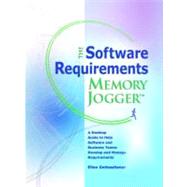The Software Requirements Memory Jogger: A Desktop Guide to Help Software and Business Teams Develop and Manage Requirements

The Software Requirements Memory Jogger: A Desktop Guide to Help Software and Business Teams Develop and Manage Requirements
- ISBN 13:
9781576811146
- ISBN 10:
157681114X
- Edition: 1st
- Format: Paperback
- Copyright: 10/15/2009
- Publisher: Goal Q P C Inc
Rent
Sorry, this item is currently unavailable.
Note: Supplemental materials are not guaranteed with Rental or Used book purchases.
Extend or Purchase Your Rental at Any Time
Need to keep your rental past your due date? At any time before your due date you can extend or purchase your rental through your account.
Summary
How to Use The Software Requirements Memory JoggerTM The Software Requirements Memory JoggerT is a quick reference guide for you to use on the job or as a supplement to your training. It is designed to facilitate communication between business and technical teams as they define requirements for software projects. It includes the tools, techniques, and models team members will use to elicit, analyze, specify, validate, and manage their software requirements. The book also contains a case study example, set off on a blue background, to show you how to use these tools, techniques, and models in each step of the process.Not sure what tool, technique, or model to use? Just refer to the User Requirements Model Roadmap in Chapter 4 to direct your efforts. Then refer to the "What Tools and Techniques Will I Use?" chart at the beginning of each chapter to guide you through the process of defining the requirements.Because many of the terms in this book may not be defined by readers in exactly the same way, we have included a glossary as one of the book's appendices, to ensure that all readers "speak the same language." The terms that are included in the glossary are shown in blue italics the first time they appear in the text, to let you know that the term is defined in the back of the book.You will also find a list of references and resources in the back of the book, in case you want to further your understanding of the tools and concepts in this Memory JoggerT. This list is not meant to be all-inclusive, but it does include the resources that the author felt would be the most helpful to the reader at the time of publication.We hope that you will find this book to be an invaluable tool that you will use often as you define, develop, and manage your requirements.Contents Acknowledgments ..iii Publisher's Note iv How to Use The Software Requirements Memory JoggerT v 1. Overview of Software Requirements 1 2. Setting the Stage for Requirements Development 27 Vision Statement Glossary Requirements Risk Mitigation Strategy 3. Elicit the Requirements 43 Requirements Source List Stakeholder Cate-gories Stakeholder Profiles Interviews with Stakeholders Facilitated Workshops Explora-tory Prototypes Focus Groups Observation User Task Analysis Existing Documentation Study Surveys Stakeholder Elicitation Plan 4. Analyze the Requirements 109 Relationship Map Process Map Context Dia-gram Event-Response Table Business Policies Actor Table Use Cases Dialog Map Data Model State Diagram Business Rules Good Modeling Practices Prioritized Requirements 5. Specify the Requirements 231 User Requirements Document Software Requirements Specification Document 6. Validate the Requirements 261 Peer Review User Acceptance Tests Model Validation Operational Prototype 7. Manage the Requirements 281 Change Control Policies and Procedures Re-quirements Attributes Requirements Trace Matrices 8. Adapting Requirements Practices to Projects 295 Project Types Change-Driven vs. Risk-Driven Projects Appendices 311 References, Bibliography, and Additional Resources Analysis Models Verbs and Phrases to Use in Requirements Models Software Requirements Specification Inspection Checklist Quality Attributes and Their Metrics Ambiguous Words and Phrases to Avoid When Describing Quality At-tributes Questions for Requirements Retro-spectives Glossary






